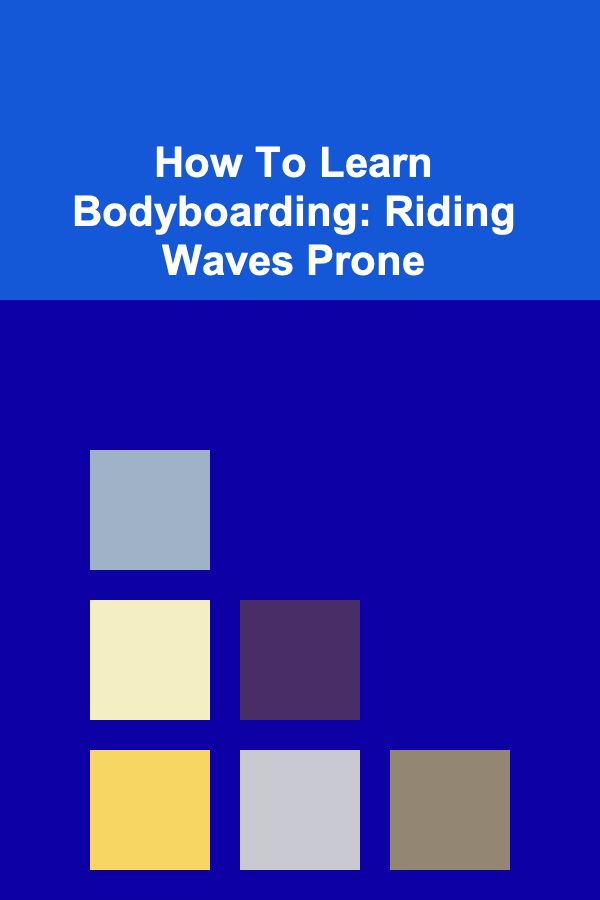
How To Learn Bodyboarding: Riding Waves Prone
ebook include PDF & Audio bundle (Micro Guide)
$12.99$10.99
Limited Time Offer! Order within the next:

Bodyboarding, a thrilling and exciting water sport, offers a unique way to enjoy the waves. For many water enthusiasts, bodyboarding can be the gateway to mastering the ocean and experiencing the rush of catching waves. Whether you're a complete beginner or looking to refine your skills, understanding the fundamentals of bodyboarding, especially riding waves prone (lying on your stomach), is key to enjoying this sport to the fullest.
This article will take you through the essential steps, techniques, and tips to help you learn how to bodyboard while riding waves prone. From choosing the right gear to mastering paddling and timing your rides, we'll cover everything you need to know to get started in this exhilarating sport.
Understanding Bodyboarding
Bodyboarding is a water sport where you ride the waves lying on a small board, usually made of foam, and without the need for a standing position. It's a versatile sport that allows you to perform maneuvers on the waves while prone (lying flat on your stomach). Bodyboarding is less physically demanding than surfing but still requires a good understanding of the ocean and wave dynamics.
In bodyboarding, you use the buoyancy of the board to help catch waves and glide across the water. The sport offers a wide range of tricks and techniques, but for beginners, learning how to ride waves prone is the best starting point.
Getting the Right Gear
Choosing the Right Bodyboard
When learning bodyboarding, selecting the appropriate board is essential for comfort, control, and performance. Here are some important factors to consider when choosing your board:
- Size: A bodyboard should be around the same height as your belly button or slightly taller. The size of the board impacts how easily you can catch waves, maneuver, and maintain balance.
- Material: The core material of a bodyboard typically consists of foam, which provides buoyancy and flexibility. More advanced boards may have a stiffer core, such as polypropylene (PP) or polyethylene (PE), which offer different levels of performance.
- Tail Shape: The tail of the bodyboard plays a significant role in maneuverability. For beginners, a crescent tail is often recommended as it provides more control and stability.
- Deck and Slick: The deck of the bodyboard is where you lie, and the slick (bottom) is where the board interacts with the water. High-quality bodyboards have a durable slick that helps with speed and glide.
Choosing the Right Fins
Fins are crucial in bodyboarding as they allow you to paddle efficiently and catch waves. The right pair of fins will make a significant difference in your ability to position yourself in the water. When choosing fins:
- Fit: Ensure that the fins fit snugly but comfortably on your feet. They should be snug enough to stay on while paddling but not so tight that they cause discomfort.
- Blade: The blade of the fins should be stiff and provide good propulsion. More rigid fins offer better control, while softer fins are easier on the feet but may not provide as much speed.
Other Gear
- Leash: A leash connects your bodyboard to your body, preventing you from losing the board in the surf. Most bodyboarders use wrist or ankle leashes.
- Wetsuit: Depending on the water temperature, you may need a wetsuit to stay warm and comfortable while riding the waves.
- Wax: Applying wax to the deck of the board ensures that you don't slip off while paddling and riding.
Learning the Basics of Paddling
Before you can ride the waves, it's essential to master the art of paddling. Proper paddling techniques help you get into position quickly and effectively.
Positioning on the Board
When lying prone on the board, make sure your body is centered. You should be in a position where your chest is aligned with the board's center, with your legs hanging off the back. This allows for the most efficient paddling and wave-catching.
The Paddling Technique
To paddle effectively, use your arms in a motion similar to swimming. Begin by extending your arms in front of you and pulling back through the water. Keep your elbows slightly bent, and aim for smooth, consistent strokes. The key is to use long, powerful strokes, which will help you gain speed and reach the waves quicker.
Your legs should be used for stability, helping to keep the board balanced while paddling. Avoid kicking too vigorously, as this can lead to instability. Instead, a gentle flutter kick is ideal to maintain balance and streamline your position.
Catching Waves: Timing and Positioning
Catching waves is arguably the most thrilling part of bodyboarding, but it requires patience, practice, and good timing. Here's how to time your ride:
Spotting the Right Wave
Not all waves are ideal for bodyboarding. The best waves for bodyboarding are those that are steep, with a well-defined breaking point. When you're starting, look for waves that are shoulder-height or smaller, as these are easier to manage.
Once you've spotted a wave, position yourself so that you're paddling toward it, ensuring that your board is facing the oncoming swell.
Timing the Takeoff
Timing is critical when catching a wave. As the wave approaches, start paddling vigorously toward the shore. You want to paddle hard enough so that the board picks up speed and aligns with the wave's energy.
As the wave starts to break and reach you, give one final strong stroke to ensure you're on the wave. If done correctly, your board will glide with the wave, and you'll begin your ride.
Using the Wave's Energy
When you're on the wave, it's important to use the wave's energy to your advantage. Keep your body positioned low on the board, with your chest pressed against the deck and your legs extended behind you. This will keep you stable as the wave propels you forward.
You can maneuver your board by shifting your weight and using subtle movements with your arms and legs. The key is to stay balanced and follow the wave's natural motion.
Developing Your Skills: Turning and Control
As you get more comfortable with riding waves prone, you'll want to develop your skills by learning to turn and control your board. Here are some tips to help you advance:
The Basic Turn
To turn your bodyboard, shift your weight toward the direction you want to go. For a right-hand turn (for regular riders), shift your body to the left and apply slight pressure on the left edge of the board. For a left-hand turn, do the opposite.
Turning is about subtle weight shifts, so don't try to force the board in any direction. Let the wave guide you while maintaining control through your body position.
Advanced Maneuvers: Spins and Re-entries
Once you're comfortable with basic turns, you can start learning more advanced maneuvers like spins and re-entries. A spin involves rotating your body and board 360 degrees while riding the wave, while a re-entry is when you carve back up the wave's face and redirect yourself back into the power zone.
These maneuvers require more control and precision, so it's best to practice them in smaller waves until you feel confident.
Safety Tips and Etiquette
Like all water sports, bodyboarding requires an understanding of safety and proper ocean etiquette. Here are some key things to keep in mind:
Safety First
- Know Your Limits: Don't attempt to ride waves that are too big for your skill level. Always start with smaller, more manageable waves and gradually work your way up.
- Learn to Swim: Bodyboarding requires swimming skills, so make sure you're confident in the water before heading out into the surf.
- Understand Rip Currents: Be aware of rip currents and how to escape them. If you find yourself caught in one, don't panic. Swim parallel to the shore to escape the current.
- Use a Leash: Always wear a leash to prevent your board from getting lost or hitting other surfers.
Respect the Ocean and Others
- Priority Rules: Just like in surfing, bodyboarders must follow priority rules when taking waves. If someone is already riding the wave, respect their space and don't drop in on them.
- Keep the Ocean Clean: Avoid littering in the ocean and always dispose of your trash responsibly. Protecting the environment is crucial for maintaining safe and clean surf conditions for everyone.
Progressing in Bodyboarding
The key to improving your bodyboarding skills is consistent practice and patience. As you spend more time in the water, you'll develop better timing, positioning, and control over your board. Eventually, you'll be able to ride more challenging waves and perform advanced maneuvers.
Watch and Learn from Others
One of the best ways to improve is by observing more experienced bodyboarders. Pay attention to how they position themselves, how they read the waves, and how they execute turns and tricks. You can also seek feedback from local bodyboarding communities or coaches to accelerate your progress.
Conclusion
Bodyboarding is an exciting and accessible water sport that offers a rewarding experience for those willing to put in the time and effort to learn. By mastering the basic techniques such as paddling, catching waves, and controlling your board, you'll be well on your way to becoming a proficient bodyboarder. Remember to practice regularly, stay safe, and enjoy the thrill of riding the waves prone. With time, you'll find yourself catching bigger waves and perfecting more complex maneuvers. Keep challenging yourself, and the rewards will follow.
Reading More From Our Other Websites
- [Home Party Planning 101] How to Create the Ultimate DIY Cocktail Bar for Your Party
- [Home Cleaning 101] How to Create a Spring Cleaning Checklist
- [Organization Tip 101] How to Create an Action Plan for Time Management Improvement
- [Personal Care Tips 101] How to Choose the Best Antiperspirant for Your Skin Type
- [Personal Financial Planning 101] How to Use the Best Investment Apps for Easy and Smart Investing
- [Personal Financial Planning 101] How to Manage Your Cash Flow for a Stress-Free Life
- [Home Storage Solution 101] How to Use Baskets and Bins to Keep Your Home Tidy and Neat
- [Beachcombing Tip 101] Eco‑Friendly Finds: Turning Beachcombing Discoveries into Sustainable Crafts
- [Personal Care Tips 101] How to Use Mouthwash to Relieve Dry Mouth
- [Mindful Eating Tip 101] From Plate to Heart: Building Stronger Family Bonds Through Mindful Eating

How to Balance Your Full-Time Job with Part-Time Writing Projects
Read More
How to Make Decadent Coffee Desserts
Read More
How to Optimize Your Nutrition for Fat Burning
Read More
How To Skateboard Like a Pro: Fundamentals
Read More
How to Soundproof a Rental Property Without Damaging It
Read More
How to Make Healthy Desserts Without Guilt
Read MoreOther Products

How to Balance Your Full-Time Job with Part-Time Writing Projects
Read More
How to Make Decadent Coffee Desserts
Read More
How to Optimize Your Nutrition for Fat Burning
Read More
How To Skateboard Like a Pro: Fundamentals
Read More
How to Soundproof a Rental Property Without Damaging It
Read More